#meiji era
Text
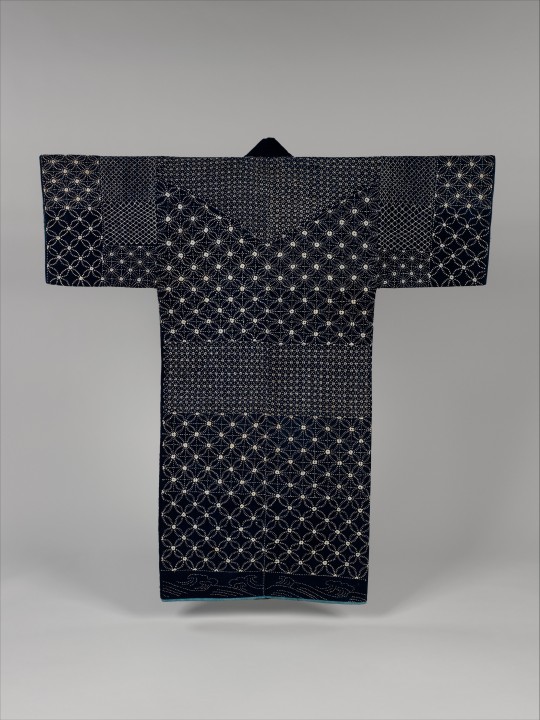
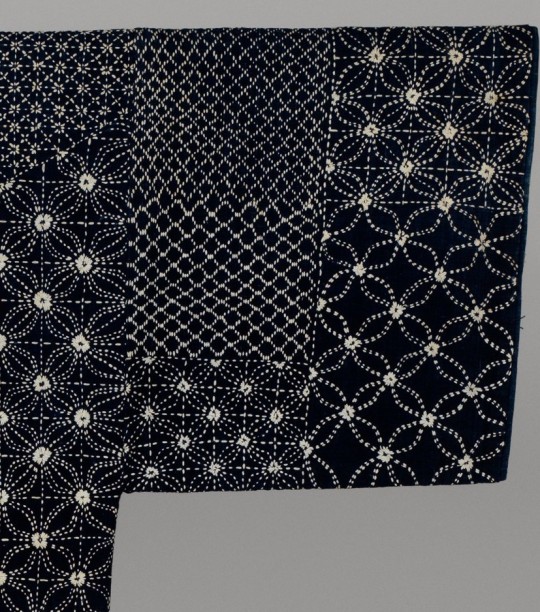
Sashiko Jacket
1850-1899 (Meiji Era)
Japan
Sashiko is a quilting technique that uses a running stitch to reinforce and prolong the life of a textile or to join together recycled pieces of cloth into a new garment. Japanese farmers used the technique to create warmer and more durable fabrics, and decorative sashiko stitching developed from this practical function. This robe’s embroidered design is dominated by three variations on the pattern of interlocking circles, called shippō-tsunagi. The bottom band features a design of waves.
The MET (Accession Number: 67.172.1)
#sashiko#fashion history#historical fashion#japanese fashion#non western fashion#japanese art#19th century#meiji era#quilting#japan#blue#off white#cotton#robe#jacket#1850s#1860s#1870s#1880s#1890s#the met
1K notes
·
View notes
Photo

Kobayashi Kiyochika (1847-1915) Morning Glories on Bamboo Stakes (woodblock, 1879)
4K notes
·
View notes
Text

Crow and Willow Tree, Kawanabe Kyosai, 1887
#art#art history#Asian art#Japan#Japanese art#East Asia#East Asian art#Kawanabe Kyosai#birds-and-flowers#animals in art#bird#birds#crow#crows#Meiji period#Meiji era#19th century art#Metropolitan Museum of Art#album leaf#ink and color on silk
6K notes
·
View notes
Text


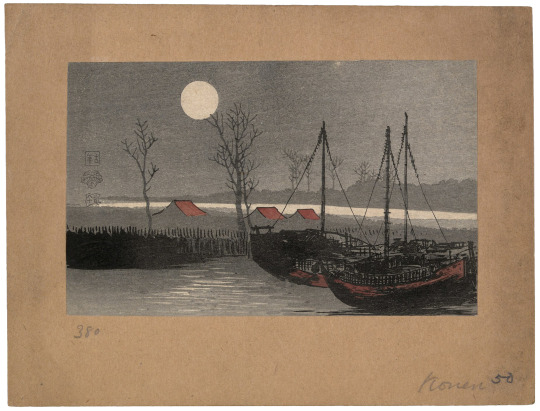
Uehara Konen - Three wintery landscapes, color woodblock prints, c.1910-1920.
914 notes
·
View notes
Photo

Two Crows on Plum Branch by Kawanabe Kyosai (1885)
#kawanabe kyosai#art#ukiyo-e#woodblock prints#fine art#19th century#19th century art#meiji era#meiji period#woodblock print#japanese art#japanese artist#nature art#crow#crows#birds#plum tree#asian art#classic art
4K notes
·
View notes
Text
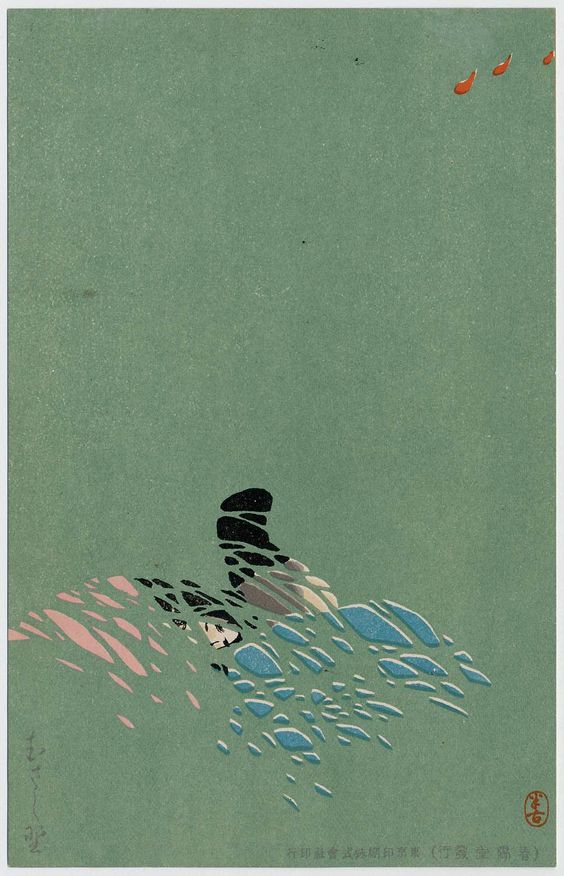
Kajita Hanko, Musashi Plain (Musashino), from the series Tales of Ise
Publisher: Shun'yôdô
Tokyo Printing Company, Late Meiji era 1903
231 notes
·
View notes
Text

Watanabe Shōtei
Seagulls Over the Waves
Meiji era (1868-1912)
#watanabe shotei#Watanabe Shōtei#modern woodblock#japanese woodblock#woodblock art#woodblocks#japanese woodblock technique#woodblock print#woodblock artist#japanese woodblock tradition#modern art#japanese print#japanese beauty#japanese artist#japanese prints#japanese art#meiji era#meiji art#meiji print#meiji period#art history#japanese art history#meiji japan#seagulls#waves#ocean view#seascape#beautiful birds#birds in art#birds in flight
337 notes
·
View notes
Text
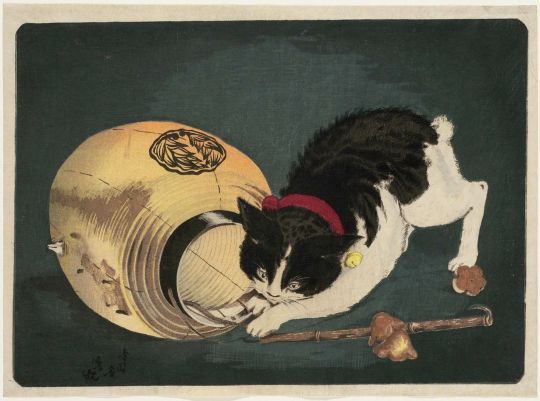
Kobayashi Kiyochika (1847-1915) ~ Cat catching a rat, 1877 (1st edition). Woodblock print (nishiki-e); ink and color on paper | src MFA Boston

Detail from a print dated 1920s | src MIA Minneapolis Institute of Art
#Kobayashi Kiyochika#cat#Katze#chat#gatto#gato#caturday#ukiyo-e#nishiki-e#japanese art#woodblock print#japanese woodblock#Meiji era#woodblock art#1870s#drawing#illustrations#rat#cat chasing rat#paper lamp#japanese lamp
104 notes
·
View notes
Text

Ohara Koson 小原古邨 [1877-1945]
280 notes
·
View notes
Text

Ambrotype of two handsome men in kimonos, dated on back Meiji 16 (1883)
#auction also noted that though the writing on the back does not identify the sitters it does say the man on right is 37#37!! look at him! and he’s pulling this off in the 19th century what is his secret… listen I’m asian too that alone won’t cut it#to be clear I have no knowledge of Japanese and cannot confirm seller’s translation accuracy but I enjoy believing in this baby-faced 37yo#19th century#1800s#1880s#meiji era#19th century fashion#fashion history#historical fashion#men's fashion#menswear#19th century photography#ambrotype#19th century men#vintage men
178 notes
·
View notes
Text

An early example of Irezumi tattoos, 1870s
#japan#japanese art#japanese photography#yakuza#meiji era#edo era#edo period#meiji period#samurai#tattoo#tattoos#irezumi#traditional tattoo#stick and poke#handpoke
295 notes
·
View notes
Text


Unlined Summer Kimono
c.1876
A pond with carp and water lilies adorns the lower part of this kimono, and morning glories bloom at the shoulders. This early summer scene is resist dyed and painted on a blue-and-white ground of high-quality silk gauze (ro), subtly patterned in the weave with goldfish in water. The donor’s grandmother, one of four generations of female textile artists, wore this summer kimono during her thirteenth year, around 1876, for her jūsan-mairi (literally, “thirteenth temple visit”) to Arashiyama Hōrinji, a temple in Saga, Kyoto, to receive blessings as she entered adolescence. The kimono has three family crests: one on the center of the back and one on each sleeve.
The MET (Accession Number: 2006.73.2)
#kimono#japanese fashion#fashion history#historical fashion#non western fashion#1870s#19th century#1876#blue#off white#japan#fish#floral#meiji era#the met#popular
1K notes
·
View notes
Text

Sakai Dōitsu (1845-1913) — Mount Horai [hanging scroll; ink, colours, gold, on silk, ca. 1889]
134 notes
·
View notes
Text
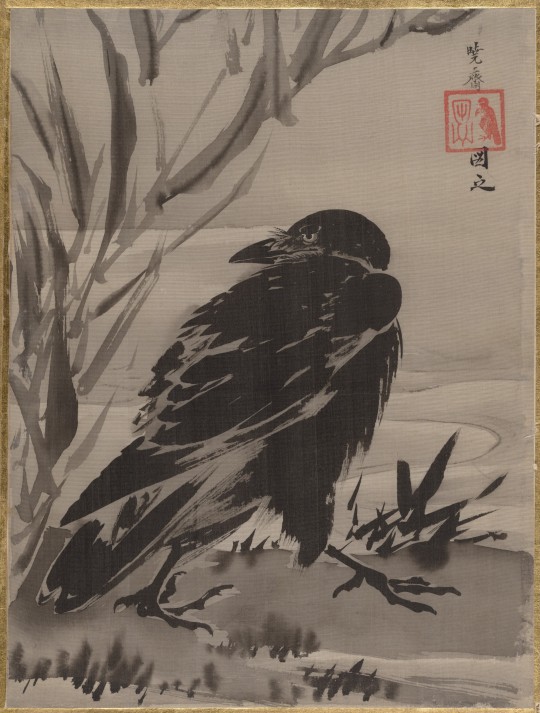
Crow and Reeds by a Stream, Kawanabe Kyōsai, ca. 1887
#art#art history#Asian art#Japan#Japanese art#East Asia#East Asian art#Kawanabe Kyosai#animals in art#crow#crows#corvid#corvids#Meiji period#Meiji era#19th century art#Metropolitan Museum of Art
984 notes
·
View notes
Text

Kiyochika Kobayashi - Rest House under the Moonlight at Imadobashi, color woodblock print, c. 1877.
121 notes
·
View notes
Text

Fireflies at Kinu River in Tennoji by Kobayashi Kiyochika (1880)
#kobayashi kiyochika#art#ukiyo-e#woodblock prints#fine art#19th century#19th century art#meiji era#meiji period#woodblock print#japanese art#japanese artist#nature art#insects#fireflies#river#landscape#asian art#classic art
2K notes
·
View notes